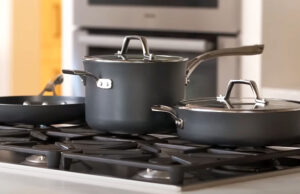As an Amazon Associate, I earn from qualifying purchases at no extra cost to you.
How to Install LG Dishwasher Easily the Right Way (6 Steps)
Have you ever stared at a brand-new LG dishwasher wondering where to even begin? I remember unboxing mine and feeling a mix of excitement and panic. The shiny appliance looked perfect, but the instructions seemed long and confusing. I asked myself, “Can I really do this without a professional?” Surprisingly, it wasn’t as hard as it seemed. With the right approach, anyone can set it up efficiently and safely.
Installing an LG dishwasher starts with measuring your space accurately, then connecting the water supply and drain hoses properly. Next, securing the appliance in place and leveling it ensures smooth operation. Electrical connections must be checked carefully, and finally, running a test cycle confirms everything works. Remember to use plumber’s tape on threaded connections, avoid over-tightening hoses, and double-check for leaks before closing the panels.
Prepare the Space and Gather Tools
Before touching the dishwasher, make sure your kitchen area is ready. Clear out the cabinet under the counter, and remove any old dishwasher carefully. Check that the floor is level; even a slight slope can cause water pooling or uneven cleaning. I once ignored this step, and my dishes kept rattling—lesson learned quickly.
Gather all tools: adjustable wrench, screwdriver, drill, pliers, and a towel for any spills. Sometimes, small items like a spirit level or tape measure make the job smoother. Imagine trying to connect hoses without knowing the exact space—frustrating, right? It’s better to have everything in reach before starting.
Check the water supply valve and power outlet nearby. LG dishwashers need proper electrical and water connections, so ensure they meet your model’s requirements. I once had a dishwasher ready to go but had to call an electrician for a nearby outlet—such a simple oversight can waste hours. Planning saves time and stress.
Finally, take a few minutes to read the LG installation manual. You don’t need to memorize it, but understanding the steps helps avoid mistakes. Think of it as a roadmap—it’s much easier to navigate once you know the route.
- Clear area and remove old dishwasher
- Level the floor and workspace
- Gather all necessary tools
- Check water and power connections
- Skim the manual for guidance
Connect the Water Supply
First, turn off the main water supply. This prevents any accidental flooding while connecting the dishwasher. I once skipped this step and got soaked—lesson learned the hard way. Next, attach the water inlet hose to the dishwasher’s connection. Make sure to tighten it securely but avoid overtightening, which can crack fittings.
Use plumber’s tape on threaded connections to prevent leaks. It’s a small detail, but it makes a huge difference. Then, connect the other end to the hot water supply under the sink. Double-check the valve orientation and make sure it’s fully open after connecting. I usually give it a gentle wiggle to ensure no leaks form.
Pay attention to the hose routing. Avoid kinks or tight bends because they can restrict water flow. I remember my first install, the hose was bent sharply, and the dishwasher didn’t fill properly. Simple adjustments saved the day. Ensure hoses are behind cabinets, out of sight, but fully functional.
Finally, inspect for leaks before proceeding further. Turn on the water briefly and watch the connections closely. Even a tiny drip can lead to damage later, so take your time. Better to catch it now than deal with a flooded kitchen.
- Turn off main water supply
- Attach and secure inlet hose with plumber’s tape
- Connect to hot water supply and open valve
- Route hoses smoothly without kinks
- Check for leaks before continuing
Install the Drain Hose
Position the drain hose according to your kitchen layout. LG dishwashers usually connect to the sink drain or garbage disposal. Avoid stretching or forcing it into tight spaces—it should follow a natural path. I remember struggling with a tight corner and realized a slight shift in positioning solved everything instantly.
Make sure the drain hose forms a high loop. This prevents backflow and keeps dirty water from re-entering the dishwasher. It’s a small trick, but it really works. Some people skip it and then wonder why their dishes smell funny. Adding a zip tie or clip can keep the loop in place securely.
Connect the hose to the drain port and secure it tightly. Check the manufacturer’s instructions for your model—some require a clamp, while others just fit snugly. I once forgot the clamp, and water slowly leaked under the sink. A quick check prevented a bigger mess.
Finally, test the drainage by pouring a small amount of water through the hose. Make sure it flows freely and doesn’t pool anywhere. This simple step ensures your dishwasher won’t overflow and keeps your kitchen clean.
- Position the drain hose naturally
- Create a high loop to prevent backflow
- Connect and secure the hose
- Test drainage with water
- Adjust if any leaks or kinks
Level the Dishwasher
Leveling ensures your dishwasher runs quietly and cleans efficiently. Place a spirit level on the top edge and adjust the front and back legs until the appliance is perfectly even. I once skipped leveling, and dishes rattled so much it scared my cat. Proper leveling is essential for smooth operation.
Check side-to-side and front-to-back alignment. Small tilts can affect spray patterns and cause pooling at the bottom. Using a wrench to turn adjustable legs slowly gives fine control. Sometimes, just a half-turn solves a lot of problems.
Make sure the dishwasher sits flush with your countertop. It looks better and prevents gaps where dust or crumbs can accumulate. I like to slide a small cardboard piece behind the legs to double-check clearance before final tightening. Attention to detail pays off.
Finally, tighten the leveling nuts but don’t overtighten. You want stability without damaging the legs or floor. Give it a gentle push to ensure it doesn’t wobble. A steady dishwasher makes life easier, especially when loading full racks.
- Use a spirit level top and side
- Adjust front and back legs gradually
- Check alignment with countertop
- Tighten legs carefully
- Ensure no wobble or tilt
Make Electrical Connections
Always turn off the main power before handling electrical connections. Safety first. LG dishwashers usually have a junction box for wiring. Remove the panel carefully and follow the manual for connecting wires. I always label wires to avoid confusion later.
Match colors correctly: black to black, white to white, green or bare to ground. Twist wires with wire nuts and secure them tightly. Loose connections can cause shorts or malfunction. It’s one of those “small steps, big consequences” moments.
Tuck wires neatly inside the box and replace the cover panel. Avoid pinching or bending wires sharply, as this can damage insulation. I like to gently push wires toward the back, giving enough room for the panel to sit flat.
Finally, restore power and test. Start a short cycle to ensure the dishwasher powers on, fills with water, and drains correctly. Seeing everything work perfectly is always satisfying—it makes all the careful prep worth it.
- Turn off main power
- Connect wires carefully following color code
- Use wire nuts and secure connections
- Tuck wires neatly in box
- Test appliance after restoring power
Secure the Dishwasher and Test
Slide the dishwasher into the cabinet space gently. Avoid bumping the sides or scratching the floor. I use a towel under the base sometimes to slide it smoothly. Check that hoses and wires aren’t pinched.
Attach mounting brackets to the countertop or side cabinets. This keeps the appliance stable and prevents movement during operation. Sometimes, brackets need a little adjustment to match your cabinet depth. A small tweak solves alignment issues quickly.
Run a full cycle without dishes first. Watch for leaks, unusual noises, or error messages. This dry run is crucial for catching problems early. I remember spotting a tiny leak at the back, fixing it saved a potential flood later.
Finally, load your first batch of dishes and enjoy. The dishwasher should run smoothly, and your kitchen is ready for daily use. Celebrate the small victory—you installed it yourself and avoided expensive service calls.
- Slide dishwasher gently into place
- Secure with mounting brackets
- Run a test cycle without dishes
- Check for leaks or unusual noises
- Enjoy fully functional appliance
Final Thoughts
Installing an LG dishwasher at home may seem daunting, but with patience and planning, it’s completely doable. From preparing the space to testing for leaks, each step matters. Taking your time ensures a safe, efficient setup. Once it’s running, the convenience of clean dishes without stress is worth every effort. Small mistakes now can save big headaches later, so pay attention to details.
| Task | Tip | Common Issue |
|---|---|---|
| Measure space | Use tape measure carefully | Misfit dishwasher |
| Gather tools | Adjustable wrench, screwdriver, pliers | Missing essential tools |
| Connect water | Use plumber’s tape | Leaks at hose connections |
| Drain hose | Make high loop | Backflow issues |
| Level appliance | Use spirit level | Uneven cleaning |
| Electrical wiring | Match color codes | Short circuits |
| Mount brackets | Secure to countertop | Wobbling dishwasher |
| Test run | Run empty cycle | Hidden leaks or errors |
Frequently Asked Questions (FAQs)
Is it necessary to turn off the main water supply?
Yes, turning off the main water supply prevents accidental flooding during installation. Even a small drip can cause damage under cabinets. I usually double-check by opening the faucet briefly to ensure water stops completely before connecting hoses. It adds only a minute but saves a lot of stress.
Can I install an LG dishwasher without a professional?
Absolutely, many homeowners successfully install LG dishwashers themselves. Following the manual and using proper tools ensures safety and correct connections. I did it once and realized planning and patience are the keys, not fancy skills.
Do I need plumber’s tape on the water connection?
Yes, plumber’s tape prevents leaks at threaded connections. I always wrap threads a couple of times before attaching hoses. It’s a small step, but it keeps your kitchen dry and protects the appliance from water damage.
Is it okay if the dishwasher isn’t perfectly level?
Leveling is crucial for proper water drainage and quiet operation. Even a slight tilt can cause pooling or rattling. I had dishes clatter in my first install until I adjusted the legs properly. Trust me, it’s worth the few extra minutes.
Can I connect the drain hose to a garbage disposal?
Yes, LG dishwashers often connect to a garbage disposal. Make sure the knockout plug is removed from the disposal inlet first. I once forgot this, and water wouldn’t drain. Simple checks prevent headaches later.
Do I need a dedicated electrical outlet?
Yes, a dedicated outlet prevents overloads and ensures safe operation. LG dishwashers require proper voltage and grounding. I recommend checking with a multimeter if you’re unsure, especially in older kitchens.
Is testing the dishwasher before use necessary?
Definitely, a dry test run helps identify leaks, drainage issues, or electrical problems. I always run an empty cycle first, and it saved me from a small water leak that would have been worse with dishes inside.
Can I adjust the dishwasher if it rattles during a cycle?
Yes, rattling often means it’s not level or the racks aren’t loaded evenly. I once shifted the legs slightly and balanced the racks, and the noise disappeared. Simple adjustments make the dishwasher quiet and efficient.



